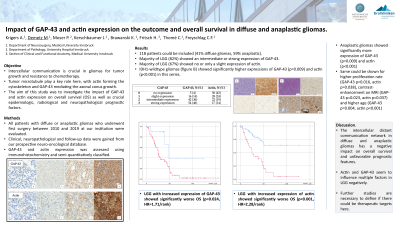Impact of GAP-43 and actin expression on the outcome and overall survival in diffuse and anaplastic gliomas
Impact of GAP-43 and Actin Expression on the Outcome and Overall Survival in Diffuse and Anaplastic Gliomas
Friday, April 21, 2023


Matthias Demetz, MD (he/him/his)
Resident
Medical University Innsbruck, Department of Neurosurgery
ePoster Presenter(s)
Introduction: Distant intercellular communication in gliomas is based on the expansion of tumor microtubuli (TMs), where actin forms cytoskeleton and GAP-43 mediates the axonal conus growth. We aimed to investigate the impact of GAP-43 and actin expression on overall survival (OS) as well as crucial epidemiologic, radiological and neuropathological prognostic factors.
Methods: FFPE tissue of adult patients with diffuse and anaplastic gliomas, who underwent first surgery in our center between 2010 and 2019, were selected. GAP-43 and actin expression was analyzed using immunohistochemistry and semi-quantitatively ranked. Clinical, neuropathological as well as follow-up-data were gained from the institutional neuro-oncological database.
Results: 118 patients with a median age of 46 years (IqR: 35 – 57) were evaluated. 48 (41%) presented with a diffuse glioma and 70 (59%) revealed anaplasia. 96 (82%) cases presented with intermediate or strong GAP-43 expression and 78 (67%) with no or light actin expression. Tumors with higher expression of GAP-43 (p=0.024, HR=1.71/rank) and actin (p < 0.001, HR=2.28/rank) showed significantly reduced OS. IDH wildtype glioma demonstrated significantly more expression of both proteins: GAP-43 (p=0.009) and actin (p < 0.001). The same was confirmed for anaplasia (GAP-43 p=0.028, actin p=0.029), higher proliferation rate (GAP-43 p=0.016, actin p=0.038), contrast-enhancement in MRI (GAP-43 p=0.023, actin p=0.037) and age (GAP-43 p=0.004, actin p< 0.001).
Conclusion : The intercellular distant communication network in diffuse and anaplastic gliomas formed by actin and GAP-43 is associated with a negative impact on overall survival and unfavorable prognostic features.
Methods: FFPE tissue of adult patients with diffuse and anaplastic gliomas, who underwent first surgery in our center between 2010 and 2019, were selected. GAP-43 and actin expression was analyzed using immunohistochemistry and semi-quantitatively ranked. Clinical, neuropathological as well as follow-up-data were gained from the institutional neuro-oncological database.
Results: 118 patients with a median age of 46 years (IqR: 35 – 57) were evaluated. 48 (41%) presented with a diffuse glioma and 70 (59%) revealed anaplasia. 96 (82%) cases presented with intermediate or strong GAP-43 expression and 78 (67%) with no or light actin expression. Tumors with higher expression of GAP-43 (p=0.024, HR=1.71/rank) and actin (p < 0.001, HR=2.28/rank) showed significantly reduced OS. IDH wildtype glioma demonstrated significantly more expression of both proteins: GAP-43 (p=0.009) and actin (p < 0.001). The same was confirmed for anaplasia (GAP-43 p=0.028, actin p=0.029), higher proliferation rate (GAP-43 p=0.016, actin p=0.038), contrast-enhancement in MRI (GAP-43 p=0.023, actin p=0.037) and age (GAP-43 p=0.004, actin p< 0.001).
Conclusion : The intercellular distant communication network in diffuse and anaplastic gliomas formed by actin and GAP-43 is associated with a negative impact on overall survival and unfavorable prognostic features.
